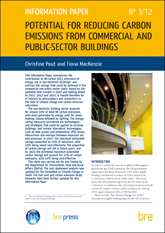
Potential for reducing carbon emissions from commercial and public-sector buildings Downloadable Version
This Information Paper summarises the contribution to UK carbon emissions of energy use in non-domestic buildings and outlines possible savings in the commercial and public-sector stock, based on the potential that existed in 2007 and looking ahead to 2012, 2017 and 2022. It will be of interest to policymakers and researchers in the field of climate change and carbon emission reductions.
The non-domestic building sector accounts for around 19% of total UK carbon emissions, with most generated by energy for space heating, closely followed by lighting. The energy-saving measures considered are technologies and strategies applicable to existing buildings, and include ‘alternative’ technologies such as heat pumps and photovoltaic arrays. Interactions and overlaps between measures are also assessed. In 2007, the maximum achievable savings amounted to 25% of emissions, with 19% being saved cost-effectively. The proportion of carbon savings will fall in future years, and by 2022 the estimated maximum achievable carbon savings will account for 17% of carbon emissions, with 14% being cost-effective.
Contents
Introduction
Carbon emissions from non-domestic buildings
Stock profile for commercial and public-sector buildings
Potential for reducing carbon emissions in the commercial and public-sector housing stock
- Assessing cost-effectiveness
- Marginal abatement cost curves
- Marginal abatement cost curves for future years
- Fuel costs and carbon-emission factors used in the analysis
Findings
- Marginal abatement cost curves
- UK potential for carbon savings
Conclusion
Appendix: Description of N-DEEM
- Classification of building/activity use and end use
References
A4 12pp
Available on or after 30/1/12.
